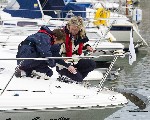 Go to main content
Go to main content
Archive Website of the UK government
Please note that this website has a UK government accesskeys system.
Main menu
Page menu
Travel and transport

Safety regulations for pleasure craft

If you use pleasure craft, like yachts, sailing boats and motorboats, there are certain safety regulations you must follow. Get safety advice and find out what you must do to make sure you and those travelling with you are safe on board.
General safety on the water
When you are out on the water, there are some general safety tips that apply to all types of pleasure craft. It may not be required by law, but you should make sure that you:
- get trained - take part in any safety training needed for your activity
- check the weather and tides before setting out
- wear a lifejacket - make sure it's right for you and the activity
- keep in touch - take some means of communication with you
- tell someone where you're going and when you'll be back
- don't drink alcohol before going in or on the water
Get trained and master basic skills
Make sure you and your crew have enough skills and experience to use the boat safely. The Royal Yachting Association (RYA) offers training for all abilities.
Safety regulations - what you must do to keep safe
Everyone using a pleasure craft must follow parts of the international safety regulations. These are set out in Chapter V of the International Convention for the Safety of Life at Sea ('SOLAS V'). If you're involved in a boating accident and you haven't followed these regulations, you could be prosecuted.
You must:
- plan your voyage
- carry a radar reflector
- carry an illustrated table of the recognised life-saving signals
- provide assistance to other craft, if needed
Planning your voyage
Before you set out:
- know your limitations - check your boat is up to the trip and has the proper safety equipment and enough supplies
- make sure your crew can also make the trip - think about their experience and physical ability
- check an up-to-date chart and a current pilot book or almanac so you're familiar with where you're going and any potential hazards
- know how to navigate yourself to safety if your global positioning system (GPS) equipment was to fail
- have a back-up plan and think about where you could take shelter if conditions deteriorated or something went wrong
Radar reflectors
Some ships rely on radar for spotting other vessels so it's vital that your boat can be seen by radar to prevent collisions.
For all vessels, you should try to fit the largest radar reflector possible for the size of your boat. The reflector should be fitted according to the manufacturer's instructions and set as high up as possible to be the most effective.
The Maritime and Coastguard Agency (MCA) has issued guidance about using radar reflectors.
Life-saving signals
You must carry on board an illustrated table of the recognised life-saving signals. This is so that you can communicate with the search and rescue services or other boats if you get into trouble.
 In an emergency
In an emergency
Call the coastguard on VHF channel 16, or dial 999 or 112
Providing assistance to other craft
You must respond to any distress signals that you see or hear and help anyone or any boat in distress as best you can. You must also let the coastguard know if any vessel in the area needs assistance.
Never send hoax or unnecessary distress signals - by misusing them you could put your own or someone else's life at risk.
Preventing collisions
All pleasure craft users must follow the International Regulations for the Prevention of Collisions at Sea ('Colregs'). All boats must be fitted with navigation lights (if sailing at night or in poor visibility), shapes and sound-signalling devices.
To avoid collisions:
- stay a safe distance away from other boats and diving boats flying the blue and white 'Alpha' flag
- always keep a good lookout to see what's coming your way
For detailed information on the regulations and the requirements for navigation lights, see the guidance from the MCA.
Preventing pollution
When using your pleasure craft, you must not discharge oil or drop rubbish into the sea. Vessels more than 12 metres long must also display a placard on board explaining how to dispose of rubbish properly.
More detailed guidance on the regulations about preventing pollution at sea is available from the MCA.
Safety equipment - what you must carry on board
If your pleasure craft is more than 13.7 metres long, you must carry certain life-saving and fire safety equipment. See 'Pleasure craft -safety equipment' for more information.
More useful links
Useful contacts
Additional links
Register your boat with the coastguard

Join HM Coastguard's voluntary safety identification scheme - if you get into difficulty, the coastguard will have information about your boat to help identify you
 Facebook
Facebook Twitter
Twitter StumbleUpon
StumbleUpon Delicious
Delicious Reddit
Reddit